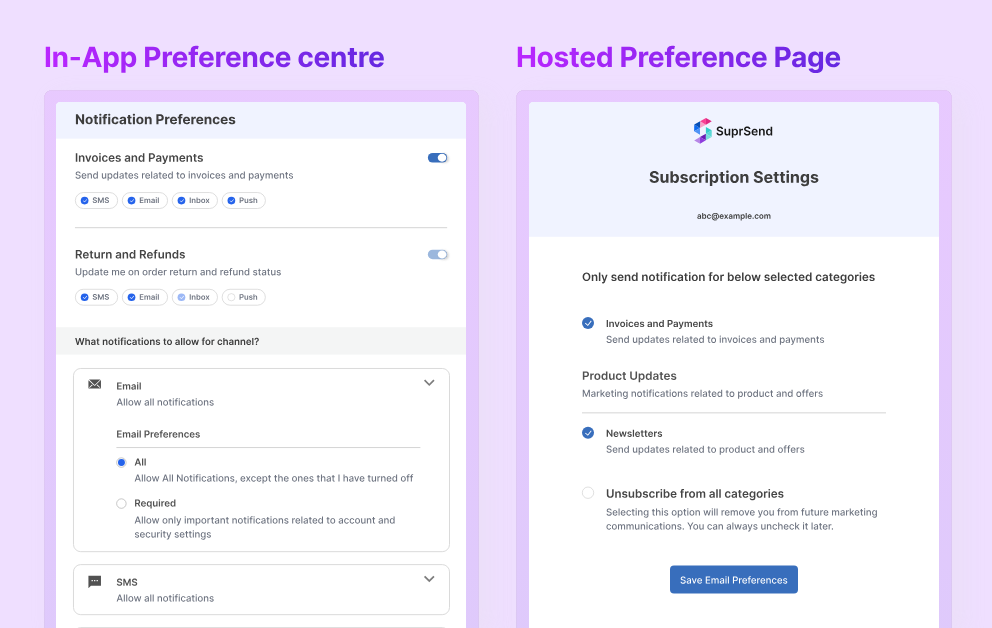Commencing on February 1st 2024, Gmail is rolling out fresh guidelines targeting bulk email senders, a move anticipated to extend gradually to other email providers. Stringent regulations are now in effect, impacting a wide array of email senders across both B2B and B2C applications. Let's delve into the details of these regulations.
1. Enhanced Authentication Protocols:
Gmail now mandates that bulk senders authenticate their emails following industry best practices. This means adopting measures that verify the sender's identity, ensuring that emails reaching your audience are legitimate. It includes SPF, DKIM, and DMARC authentication.
It means all your product emails will get affected such as summaries, digests, pending reports, broadcasts, and marketing use-cases included will now have to be authenticated to verify the sender account. Without this in place, these emails might not get delivered hampering your product engagement rates.
Setting the authentication would require a little technical help from your development team. We have outlined the detailed process for the same in this article, which you can forward to your technical team or do it yourself. Authenticating Your Emails: A Developer's Guide to SPF, DKIM, and DMARC
Error Example:

2. Streamlined Unsubscription Processes:
Gmail is emphasizing user-friendly experiences by requiring large senders to (5,000+ emails/ day) enable easy unsubscription with just one click. This ensures that your recipients have a seamless process to opt-out of commercial emails.

Example: A customer who no longer wishes to receive promotional emails from your business can now effortlessly unsubscribe with a single click. This not only respects their preferences but also helps maintain a positive brand image.
Any business can easily generate and incorporate a one-click 'Unsubscribe' button as stated by Google in under 5 minutes through SuprSend's preference management center.
We offer a self-hosted preference management center that is compatible with all major email providers, including Google and Yahoo. For additional information on preferences and the Unsubscribe feature, explore further here. - The Ultimate Guide to Perfecting Notification Preferences: Putting your users in Control

Signup now to get the one-click 'Unsubscribe' buttom on your emails and follow Gmail policies.
3. Maintaining a Low Spam Rate:
To combat spam, Gmail will enforce a clear spam rate threshold that senders must adhere to. This industry-first approach aims to keep unwanted messages out of your audience's inboxes. Gmail suggests to keep the spam score below 0.1%, and avoid ever reaching the 0.3% ceiling after which manual penalty might be in place.
You can check your current email spam rate using Google Postmaster tool. A detailed step-by-step guide is here How to Identify Email Spam Rate with Google Postmaster in the Next 60 Seconds?
A significant concern arising from this policy is the challenge of separating domains for distinct purposes such as marketing, sales, and product-related activities. Many businesses we engage with currently utilize the same domains for these diverse use-cases, which will now potentially face penalties under the new Google email policies if there's an uptick in the spam score in one specific use-case.
While our consistent advice has been to use separate vendors and domains for different use-cases, we acknowledge that making sudden changes to your current notification setup may be impractical. To assist businesses facing this challenge, we've developed a unified notification infrastructure where you can categorize your system, product, and marketing emails separately, each with its own vendor setup.
Even if your business currently uses the same email provider for all purposes, you can still set up your email notification system on our platform using your existing vendor API details for these distinct notification categories. So it would keep your pipelines separate even while sticking to the same email vendor as before. A sample reference is attached below.

This is our domain’s current email spam rate, you would see something similar for yours too.

Adapting to the Changes for the New Email Policies from Gmail
1. Authentication Best Practices:
To comply with Gmail's new regulations, businesses should prioritize adopting authentication protocols like SPF (Sender Policy Framework) and DKIM (DomainKeys Identified Mail). These measures not only bolster security but also enhance the trustworthiness of your email communications.
2. User-Friendly Unsubscription Options:
Evaluate your current email systems to ensure that unsubscribing is a straightforward process for your recipients. Implementing one-click unsubscribe options aligns with Gmail's requirements and fosters a positive user experience.
3. Monitoring and Adapting:
Regularly monitor your email campaigns and analyze their performance. Adjust your strategies as needed to maintain a low spam rate and ensure that your communications are both effective and compliant.
Keep separate email pipelines for different use-cases with different providers if possible. It would ensure that any issues with one pipeline wouldn’t affect the other one such as product use-cases.
Collaborative Industry Efforts
It's not just Gmail advocating for these changes; industry leaders are recognizing the need for a secure and user-friendly email environment including Yahoo. Collaborate with your email service provider and fellow businesses to stay informed and collectively work towards setting new industry standards.
Conclusion
As businesses, the onus is on us to adapt to the ever-evolving digital landscape. The recent Gmail updates serve as a catalyst for improved email security and user experiences. By understanding and implementing these changes, businesses can not only comply with the latest regulations but also build trust and credibility in their email communications. Embrace the shift, secure your emails, and continue to foster meaningful connections with your audience.







